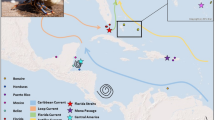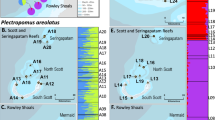Abstract
Here the population genetic structure of an ecologically and economically important coral reef fish, the coral trout Plectropomus leopardus, is investigated in the context of contemporary and historical events. Coral trout were sampled from four regions (six locations) and partial mtDNA D-loop sequences identified six populations (Fst = 0.89209, P < 0.0001): Scott Reef and the Abrolhos Islands in west Australia; the Great Barrier Reef (GBR), represented by northern and southern GBR samples; New Caledonia and Taiwan, with Taiwan containing two genetic lineages. Furthermore, this study identified source and sink populations within and among regions. Specifically, the northern population in west Australia (Scott Reef) was identified, as the source for replenishment of the Abrolhos population, whilst New Caledonia was a source for recruitment to the GBR. Based on these insights from a single mtDNA marker, this study will facilitate the development of rational management plans for the conservation of P. leopardus populations and therefore mitigate the risk of population declines from anthropogenic influences.




Similar content being viewed by others
References
Bay LK, Choat JH, van Herwerden L, Robertson DR (2004) High genetic diversities and complex genetic structure in an Indo-Pacific tropical reef fish (Chlorurus sordidus): evidence of an unstable evolutionary past? Mar Biol 144:757–767
Beerli P, Felsenstein J (2001) Maximum likelihood estimation of a migration matrix and effective population sizes in n subpopulations by using a coalescent approach. Proc Natl Acad Sci USA 98:4563–4568
Benzie JAH (1999) Genetic structure of coral reef organisms: ghosts of dispersal past. Am Zool 39:131–145
Brinkman R, Wolanski E, Deleersnijder E, McAllister F, Skirving W (2002) Oceanic inflow from the Coral Sea into the Great Barrier Reef. Estuar Coast Shelf Sci 54:655–668
Chenoweth SF, Hughes JM, Keenan CP, Lavery S (1998) When oceans meet: a teleost shows secondary intergradation at an Indian–Pacific interface. Proc R Soc Lond B 265:415–420
Crandall ED, Frey MA, Grossberg RK, Barber PH (2008) Contrasting demographic history and phylogeographical patterns in two Indo-Pacific gastropods. Mol Ecol 17:611–626
Doherty PJ, Fowler AJ, Samoilys MA, Harris DA (1994) Monitoring the replenishment of coral trout (Pisces: Serranidae) populations. Bull Mar Sci 54(1):343–355
Drummond AJ, Rambaut A (2007) BEAST: Bayesian evolutionary analysis by sampling trees. BMC Evol Biol 7:214
Excoffier L, Smouse PE, Quattro JM (1992) Analysis of molecular variance inferred from metric distances among DNA haplotypes: application to human mitochondrial DNA restriction data. Genetics 131:479–491
Godfrey JS, Ridgway KR (1985) The large-scale environment of the poleward-flowing Leeuwin current, Western Australia: longshore steric height gradients, wind stresses and geostrophic flow. J Phys Oceanogr 15:481–495
Hall TA (1999) BioEdit: a user-friendly biological sequence alignment editor and analysis program for Windows 95/98/NT. Nucleic Acids Symp Ser 41:95–98
Heemstra PC, Randall JE (1993) FAO species catalogue, vol 16. Groupers of the world (family Serranidae, subfamily Epinephelinae). An annotated and illustrated catalogue of the grouper, rockcod, hind, coral grouper and lyretail species known to date. FAO Fish Synop 125(16):382
Horne JB, van Herwerden L, Choat JH, Robertson DR (2008) High population connectivity across the Indo-Pacific: congruent lack of phylogeographic structure in three reef fish congeners. Mol Phylogenet Evol 49:629–638
Hubbard DK, Zankl H, Van Heerden I, Gill IP (2005) Holocene Reef Development along the Northeastern St. Croix Shelf, Buck Island, U.S. Virgin Islands. J Sediment Res 75:97–113
Hutchings JA (2000) Collapse and recovery of marine fishes. Nature 406:534–536
Jensen JL, Bohonak AJ, Kelley ST (2005) Isolation by distance, web service. BMC Genetics 6: 13. v.3.15. http://ibdws.sdsu.edu/)
Jones GP, McCormick MI, Srinivasan M, Eagle JV (2004) Coral decline threatens fish biodiversity in marine reserves. Proc Natl Acad Sci USA 101:8251–8253
Klanten O, Choat J, van Herwerden L (2007) Extreme genetic diversity and temporal rather than spatial partitioning in a widely distributed coral reef fish. Mar Biol 150:659–670
Knittweis L, Kraemer WE, Timm J, Kochzius M (2009) Genetic structure of Heliofungia actiniformis (Scleractinia: Fungiidae) populations in the Indo-Malay Archipelago: implications for live coral trade management efforts. Conserv Genet 10:241–249
Kocher TD, Thomas WK, Meyer A, Edwards SV, Pääbo S, Villablanca FX, Wilson AC (1989) Dynamics of mitochondrial DNA evolution in animals: amplification and sequencing with conserved primers. Proc Natl Acad Sci USA 86:6196–6200
Larcombe P (2004) Holocene Great barrier Reef: sedimentary controls and implications for environmental management. In: Gostin VA (ed) Gondwana to greenhouse: Australian environmental geoscience. Geological Society of Australia Special Publication 21
Leis JM, Carson-Ewart BM (1999) In situ swimming and settlement behaviour of larvae of an Indo-Pacific coral-reef fish, the coral trout Plectropomus leopardus (Pisces: Serranidae). Mar Biol 134:51–64
Lukoschek V, Waycott M, Marsh H (2007) Phylogeography of the olive sea snake, Aipysurus laevis (Hydrophiinae) indicates Pleistocene range expansion around northern Australia but low contemporary gene flow. Mol Ecol 16:3406–3422
McCafferty S, Bermingham E, Quenouille B, Planes S, Hoelzer G, Asoh K (2002) Historical biogeography and molecular systematics of the Indo-Pacific genus Dascyllus (Teleostei: Pomacentridae). Mol Ecol 11:1377–1392
Meyers G (1996) Variation of Indonesian throughflow and the El Niño-Southern Oscillation. J Geophys Res 101:12255–12264
Munday PL (2004) Habitat loss, resource specialization, and extinction on coral reefs. Glob Chang Biol 10:1642–1647
Myers RA, Worm B (2003) Rapid worldwide depletion of predatory fish communities. Nature 423:280–283
Pandolfi JM, Tudhope AW, Burr G, Chappell J, Edinger E, Frey M, Steneck R, Sharma C, Yeates A, Jennions M, Lescinsky H, Newton A (2006) Mass mortality following disturbance in Holocene coral reefs from Papua New Guinea. Geology 34:949–952
Pauly D, Christensen V, Gúenette S, Pitcher T, Sumaila UR, Walters C, Watson R, Zeller D (2002) Towards sustainability in world fisheries. Nature 418:689–695
Posada D, Crandall KA (2001) Intraspecific gene genealogies: trees grafting into networks. Trends Ecol Evol 16:37–45
Roberts CM (1997) Connectivity and management of Caribbean coral reefs. Science 278:1454–1457
Rohlf (1973) Algorithm 76. Hierarchical clustering using the minimum spanning tree. Comput J 16:93–95
Rousset F (1997) Genetic differentiation and estimation of gene flow from F-Statistics under isolation by distance. Genetics 145:1219–1228
Russ GR, Cheal AM, Dolman AM, Emslie MJ, Evans RD, Miller I, Sweatman H, Williamson DH (2008) Rapid increase in fish numbers follows creation of world's largest marine reserve network. Curr Biol 18:514–515
Sambrook J, Fritch EF, Maniatis T (1989) Molecular Cloning: a Laboratory Manual, 2nd edn. Cold Spring Harbour Laboratory Press, Cold Spring Harbour
Samoilys MA (1997) Periodicity of spawning aggregations of coral trout Plectropomus leopardus (Pisces:Serranidae) on the northern Great Barrier Reef. Mar Ecol Prog Ser 160:149–159
Schneider S, Roessli D, Excoffier L (2000) A software for population genetics data analysis (ARLEQUIN)
Slatkin M (1987) Geneflow and the geographic structure of natural populations. Science 236:787–792
Smith SV, Buddemeier RW (1992) Global change and coral reef ecosystems. Ann Rev Ecol Syst 23:89–118
Smith WL, Craig MT (2007) Casting the Percomorph net widely: the importance of broad taxonomic sampling in the search for the placement of Serranid and Percid Fishes. Copeia 2007(1):35–55
Swofford DL (1999) PAUP*: phylogenetic analysis using parsimony. Sinauer Associates, Champaign
Swofford DL (2000) PAUP*. Phylogenetic analysis using parsimony (*and other methods). Version 4. 10b. Sinauer Associates, Sunderland
van Herwerden L, Davies CR, Choat JH (2002) Phylogenetic and evolutionary perspectives of the Indo-Pacific grouper, Plectropomus species on the Great Barrier Reef, Australia. J Fish Biol 60:1591–1596
van Herwerden L, Choat JH, Dudgeon CL, Carlos G, Newman SJ, Frisch A, van Oppen MJH (2006) Contrasting patterns of genetic structure in two species of the coral trout Plectropomus (Serranidae) from east and west Australia : Introgressive hybridisation or ancestral polymorphisms. Mol Phylogenet Evol 41:420–435
Van Oppen MJH, Gates R (2006) Conservation genetics and the resilience of reef-building corals. Mol Ecol 15:3863–3883
Voris HK (2000) Maps of Pleistocene sea levels in Southeast Asia: shorelines, river systems and time durations. J Biogeogr 27:1153–1167
Webster JM, Beaman RJ, Bridge T (2008) From Corals to Canyons: the Great Barrier Reef margin. EOS Trans Am Geophys Union 89:217–218
Weir BS (1996) Genetic data analysis II: methods for discrete genetic data. Sinauer Assoc., Inc., Sunderland, MA, USA
Weir BS, Cockerham CC (1984) Estimating F statistics for the analysis of population structure. Evolution 38:1358–1370
Welch DJ, Mapstone BD, Begg GA (2008) Spatial and temporal variation and effects of changes in management in discard rates from the commercial reef line fishery of the Great Barrier Reef, Australia. Fish Res 90:247–260
Williams ST, Benzie JAH (1998) Evidence of a biogeographic break between populations of a high dispersal starfish: congruent regions within the Indo-West Pacific defined by color morphs, mtDNA, and allozyme data. Evolution 52:87–99
Zwickl DJ (2006) Genetic algorithm approaches for the phylogenetic analysis of large biological sequence datasets under the maximum likelihood criterion. PhD dissertation, The University of Texas at Austin
Acknowledgments
This study was funded by grants to JHC and LVH from James Cook University’s Competitive Research Incentive Grant Scheme; the Department of Environment, Heritage, Water and Arts for funding collection and processing of material from the Coral Sea; and the Department of Fisheries, Government of Western Australia for logistical support to collect samples from WA. We thank JP Hobbs, Craig Skepper, Kim Nardi, Chris Dibden, Glenn Almany and Will Robbins, for assisting in sample collection from WA and the Coral Sea. Brett Molony and Vanessa Messmer kindly provided samples from New Caledonia. We thank Emmanuelle Botte for extracting DNA from new tissue samples from Scott Reef, which were used in this study. Final thanks to David Williamson and Richard Evans for unpublished observations pertaining to PLD values of coral trout.
Author information
Authors and Affiliations
Corresponding author
Additional information
Communicated by T. Reusch.
Rights and permissions
About this article
Cite this article
Van Herwerden, L., Howard Choat, J., Newman, S.J. et al. Complex patterns of population structure and recruitment of Plectropomus leopardus (Pisces: Epinephelidae) in the Indo-West Pacific: implications for fisheries management. Mar Biol 156, 1595–1607 (2009). https://doi.org/10.1007/s00227-009-1195-0
Received:
Accepted:
Published:
Issue Date:
DOI: https://doi.org/10.1007/s00227-009-1195-0




